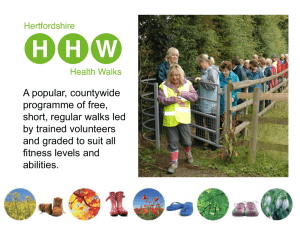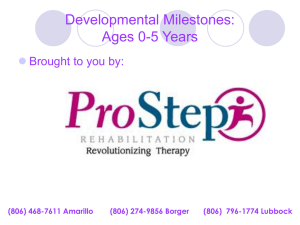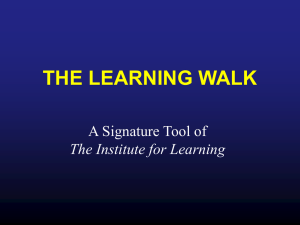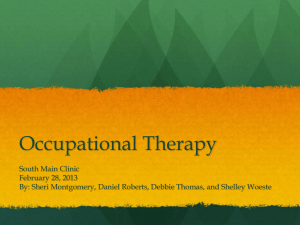Creative Movement
advertisement
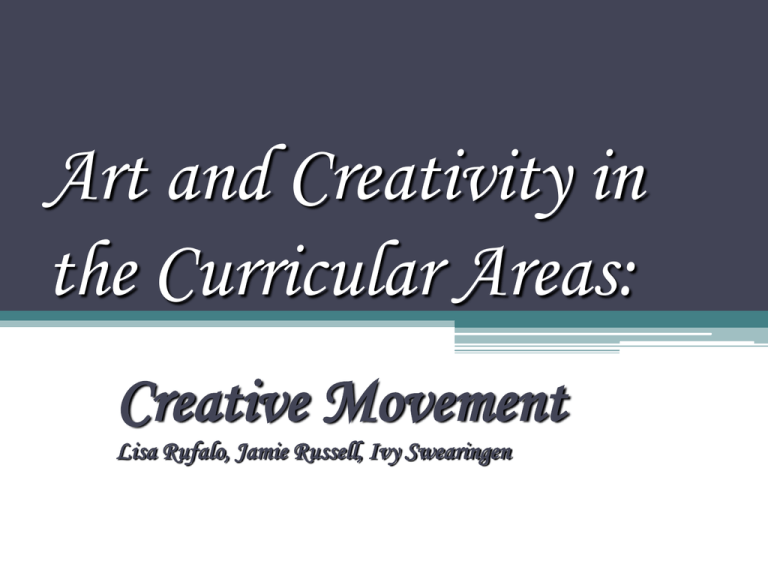
Art and Creativity in the Curricular Areas: Creative Movement Lisa Rufalo, Jamie Russell, Ivy Swearingen Importance of Creative Movement • • • • • • • • • • Reflects the mood/state the child is in Valuable at any age Motor development influences all aspects of development Offers rich opportunities for development of the child’s total self Children are free to express their own personalities in their own styles Relaxation and freedom in the use of the body Experience in expressing space, time, and weight Increased awareness of the world Experience in creatively expressing feelings and ideas Improvement of coordination and rhythmic interpretation Mayesky, 2006, p.318 Motor Skill Development: Infants • Birth-1 Month ▫ Lifts head slightly ▫ Turns head from side to side ▫ Follows objects with eyes • 1-3 Months ▫ Raises head and chest ▫ Supports upper body with arms ▫ Stretches legs out and kicks ▫ Open and shuts hands ▫ Pushes down on legs when placed on a hard surface ▫ Brings hands to mouth ▫ Grasps and shakes toys with hands • 4-7 Months ▫ Rolls from back to belly and belly to back ▫ Sits with and then without support of hands ▫ Supports whole weight on legs with assistance ▫ Reaches with one hand ▫ Transfers objects from hand to hand • 8-12 Months ▫ Leans over steadily ▫ Can sit up without assistance ▫ Crawls on belly and then on hands and knees ▫ Stands momentarily and then walks 2-3 steps ▫ Can manipulate smaller objects with hands Ames, 1979, p. 14-16, & Shelov, 2005, p.180-237 Motor Skill Development : Toddlers 1 year olds • • • • • • • • • 2 year olds Kneels and Crawls Can walk independently Walks short distances at a fast pace Climbs into child sized furniture Can move and dance from side to side Jumps and Climbs Can string large beads Creeps up stairs Can do simple art activities (Finger painting and Scribbling) • • • • • • • • • • • Stands on one foot Dressing and undressing Builds towers up to 6 blocks high Runs Kicks a ball Can pull toys behind them when walking Can carry bulky items while walking Tip toes Walks up and down stairs with support Uses one hand over the other (Right or left hand preference, or ambidextrousness) Can turn knobs and pages of a book Bailey and Burton, 1982, p. 28, & Yorke, 2004, p. 116-117 Motor Skill Development : Preschoolers 3 year olds 4 year olds Runs around corners and things in their path Kicks a ball Throws a ball 10 ft. Balances on one foot (1 – 5 seconds) Walks up stairs alternating feet Balances and walks on 5” wide board Catches a big ball bounced from 3 feet away Hops on one foot Walks heel to toe Begins to do a forward somersault Begins to pump on a swing Walks a short distance on tiptoes Climbs up and down small slide by self Walks a straight line Hops on one foot (at least 5 times) Pedals and steers tricycle skillfully Jumps over objects 5-6” high Runs, jumps, hops, and skips around obstacles w/ease Catches, bounces and throws ball easily Can do a forward somersault Jumps over knee high obstacles (older 4 yr. old) Stands on one foot for 10 seconds Walks on balance beam Jumps backward Walks downstairs alternating feet Cryer, 1996, p.52-68, & Cryer, 1996, p. 36-44 Creative Movement in the Curriculum ▫ Poetry and Stories Acting out Stories Rhythm of Poetry ▫ Dramatic Play Dolls Puppets ▫ Music CD’s and Tapes Children can chose to copy another child, or create their own moves Musical Instruments Mirror Dancing Dancing with a partners ▫ Art Dancing a Painting or Painting a Dance Sound Collages Mayesky, 2006, p. 318-325 Activities and Materials: Infants • Birth- 1 Month ▫ Following objects with eyes • 1- 3 Months ▫ Belly and back play, Rolling from side to side • 4- 6 Months ▫ Reaching activities,, Propping arms and legs into crawling position, Side lying and rolling activities, Foot play, Pre-sitting activities, Mirror play • 7- 10 Months ▫ Pivoting, Crawling, Bear walking, Sitting activities. Leaning activities, Balancing • 10- 12 Months ▫ Kneeling, Standing, Squatting ▫ Noisy, colorful, light up toys ▫ Noisy, colorful, light up toys ▫ Caregivers support, Mirrors, Boppy pillow ▫ Boppy pillow, Balls, Balancing/support bar, Climber ▫ Push toys, Walkers, Excersaucers, Jumpers, Activity tables Yorke, 2004, p 37-90 Activities and Materials: Toddlers • Fast walking and running • Jumping • Painting with finger paints • Playdoh • Scribble with crayons, markers, etc. • Climbing on soft equipment and furniture • • • • • • • • Hide and Seek Dancing with partners Catching bubbles Throwing, kicking, and rolling balls Nature walks Push and pull toys Bench sitting Coloring pages Yorke, 2004, p. 116-117 Activities and Materials: Preschoolers • Large muscle/gross motor play indoors and outdoors to include: balls, parachute play, sand/water play and obstacle courses • Opportunities for creative play on play yard equipment such as a jungle gym which can easily become a rocket ship, jungle safari, etc. • Follow the leader, Simon Says and simple small group games like Duck, Duck Goose which encourage listening, large muscle movement and cooperation • Creative Storytelling and Dance using entire bodies to act like falling leaves, recreate a story or use their bodies to simulate different cultural dances • Scarves, streamers, bubbles and other creative medium to allow children to express themselves physically • Tricycles and small riding toys • Balance beams, tumbling mats, tunnels, and other gymnastic type equipment • Swings and slides (indoor and outdoor if permitted) • Large painting opportunities using murals, easels, etc. where full body movement is allowed in creating the artwork Cryer, 1996, p.52-68, and Cryer, 1996, p. 36-44 The Teacher’s Role: General Suggestions • Keep in mind the characteristics of each age group • Encourage children to experience freedom of movement in their own • Teach children to respect and appreciate each others differences in style and movement • Use child oriented materials (i.e. Music selection) • Make sure there is enough space provided for movement activities way • Follow large motor activities with quiet activities • Be animated and energetic during movement activities • Integrate movement activities into the daily schedule • Base your expectations on the children’s developmental levels • Gradually build children’s strength and endurance • Encourage parents to send children to school in attire appropriate for movement • Support motor development through the stages by assisting children with difficult tasks Mayesky, 2006, p. 318, 321, and 326 Special Needs: Developmental Delays • Use exercise videos with a developmentally delayed child • Encourage children to participate in activities for gradually longer periods of time • Demonstrate the activity first • Familiarize yourself with the motor development sequence Mayesky, 2006, p. 326 Special Needs: Physical Impairment • Assist children, but encourage them to move independently • Allow children shorter duration of motor activities • If the child is having trouble participating, give them a the role of the “time keeper”, but also encourage them to do what they can Mayesky, 2006, p. 326 Special Needs: ADD/ADHD • Teach children how to act during movement activities • Give praise for following directions • Define the child’s personal space during movement activities • Structure activities to eliminate waiting • Keep activities short to keep the child’s attention and avoid over stimulation • Give clear directions if you are not going to offer the child a choice Mayesky, 2006, p. 326-327 Special Needs: Visual Impairments • • • • Describe everything in detail Use the child’s name to get their attention Allow children to explore equipment before the use it Assist the child through movement activities by telling them what will happen next Mayesky. 2006, p. 327 References • Ames, L. B., Gillespie, B. S., Haines, J., and Ilg, F. L. (1979). The Gessell Institute’s Child from One to Six, (14-16). New York: Harper and Row Publishers • Bailey, R. A., and Burton, E. C. (1982). The Dynamic Infant, (28). New York: Toys ‘n Things Press • Cryer, D, Harris, T. and Richardson Ray, A. (1996). Active Learning for Fours, (52-68). New Jersey: Dale Seymour Publications, Inc. • Cryer, D, Harris, T. and Richardson Ray, A. (1996). Active Learning for Threes, (36-44). New Jersey: Dale Seymour Publications, Inc. • Mayesky, M. (2006). Creative Movement. Creative Activities for Young Children 8th Edition, (318-334). New York: Thomson Delmar Learning • Shelov, S. P. (2005). Caring for Your Baby and Young Child 4th Edition, (180-237). Bantam Books • Yorke, L. L. (2004). Why Motor Skills Matter, (37-90). New York: Contemporary Books

